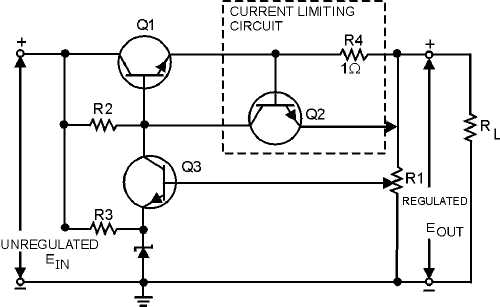4-52
Figure 4-50.—Series regulator with current limiting.
When load current is below 600 milliamperes, the base-to-emitter voltage on Q2 is not high enough
to allow Q2 to conduct. With Q2 cut off, the circuit acts like a series regulator.
When the load current increases above 600 milliamperes, the voltage drop across R4 increases to
more than 0.6 volt. This causes Q2 to conduct through resistor R2, thereby decreasing the voltage on the
base of pass transistor Q1. This action causes Q1 to conduct less. Therefore, the current cannot increase
above 600 to 700 milliamperes.
By increasing the value of R4, you can limit the current to almost any value. For example, a 100-
ohm resistor develops a voltage drop of 0.6 volt at 6 milliamperes of current. You may encounter
current-limiting circuits that are more sophisticated, but the theory of operation is always the same. If you
understand this circuit, you should have no problem with the others.
TROUBLESHOOTING POWER SUPPLIES
Whenever you are working with electricity, the proper use of safety precautions is of the utmost
importance to remember. In the front of all electronic technical manuals, you will always find a section on
safety precautions. Also posted on each piece of equipment should be a sign listing the specific
precautions for that equipment. One area that is sometimes overlooked, and is a hazard especially on
board ship, is the method in which equipment is grounded. By grounding the return side of the power
transformer to the metal chassis, the load being supplied by the power supply can be wired directly to the
metal chassis. Thereby the necessity of wiring directly to the return side of the transformer is eliminated.
This method saves wire and reduces the cost of building the equipment, and while it solves one of the
problems of the manufacturer, it creates a problem for you, the technician. Unless the chassis is physically
grounded to the ship's ground (the hull), the chassis can be charged (or can float) several hundred volts
above ship's ground. If you come in contact with the metal chassis at the same time you are in contact
with the ship's hull, the current from the chassis can use your body as a low resistance path back to the
ship's ac generators. At best this can be an unpleasant experience; at worst it can be fatal. For this reason
Navy electronic equipment is always grounded to the ship's hull, and approved rubber mats are required

